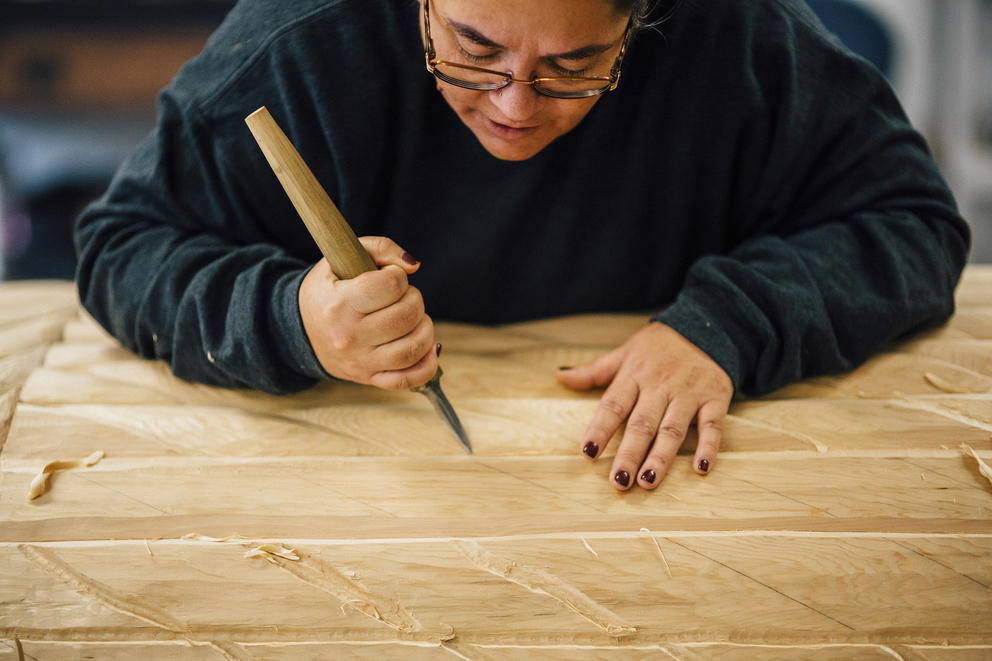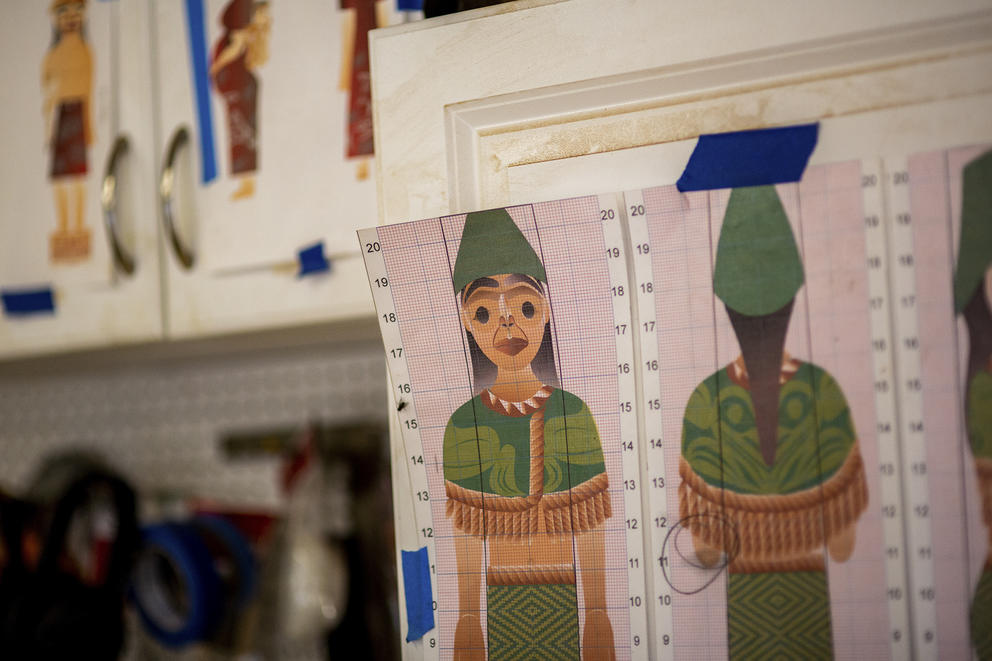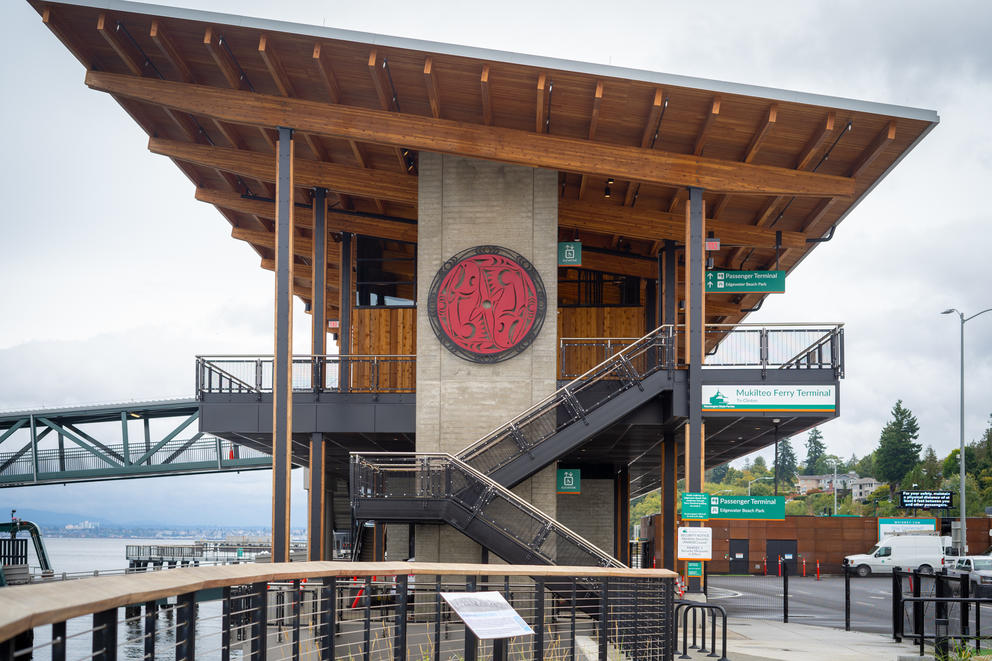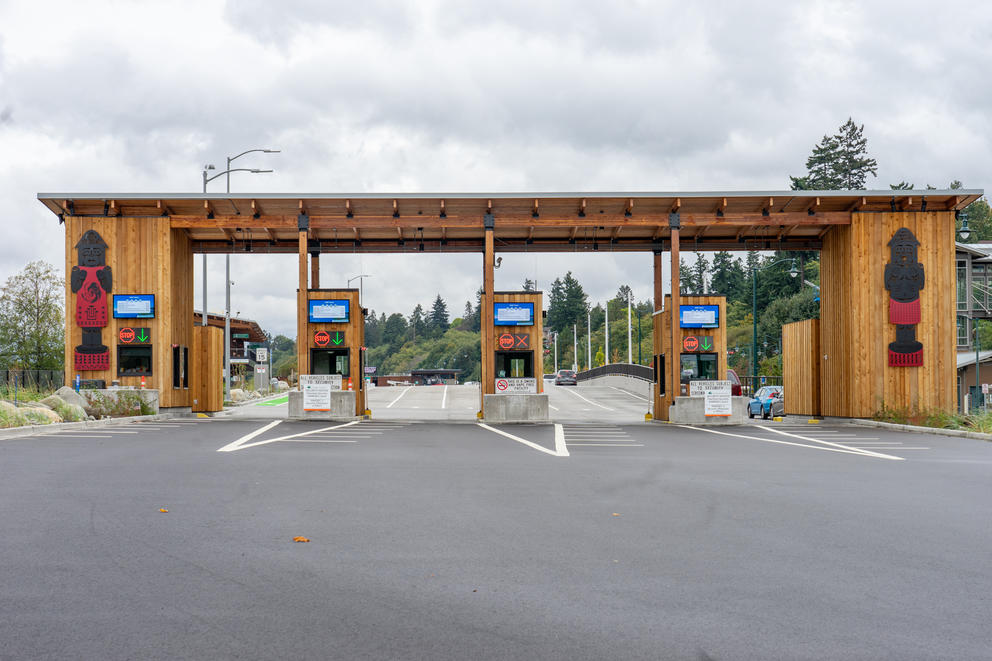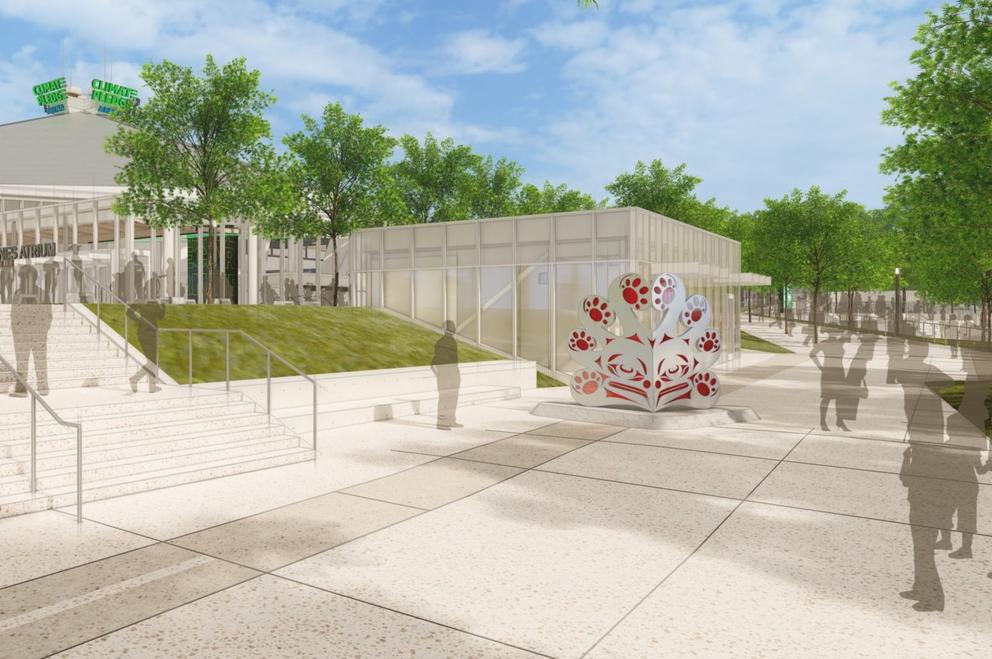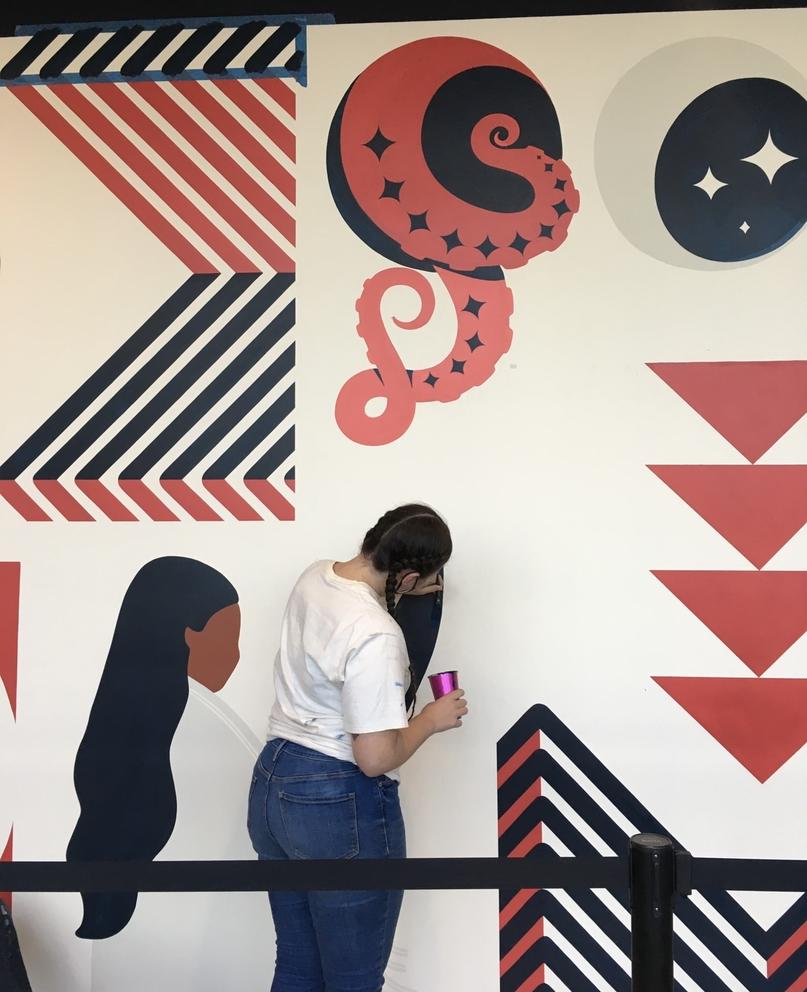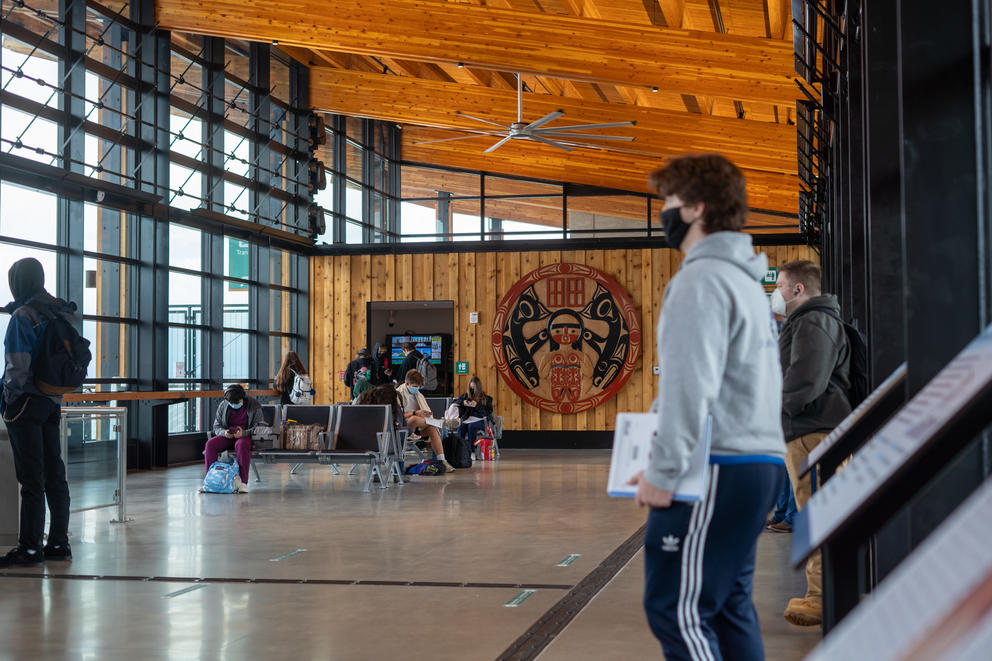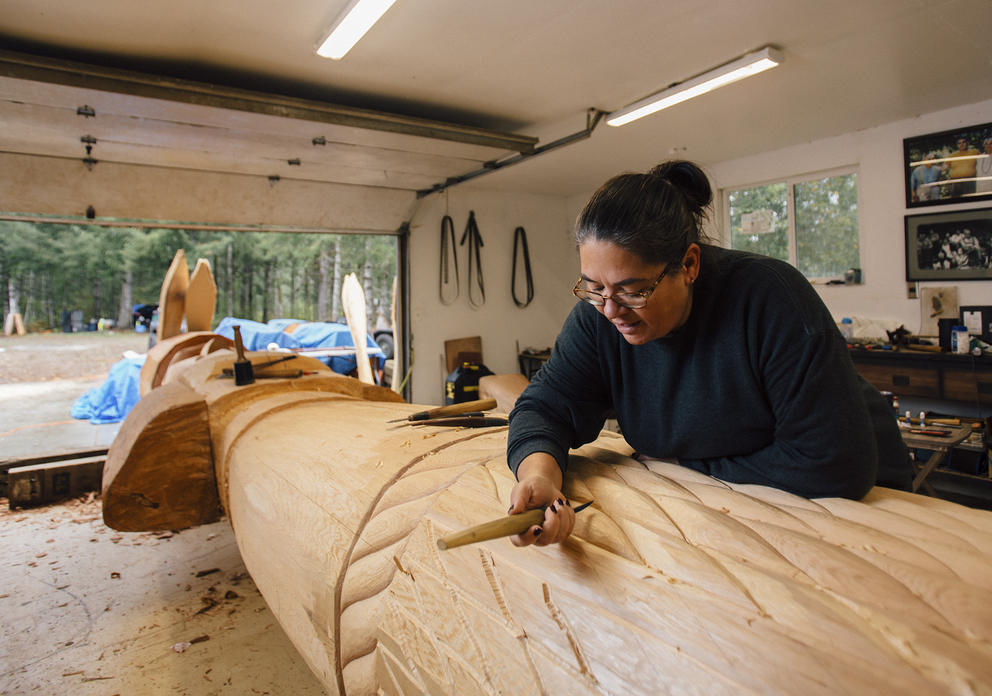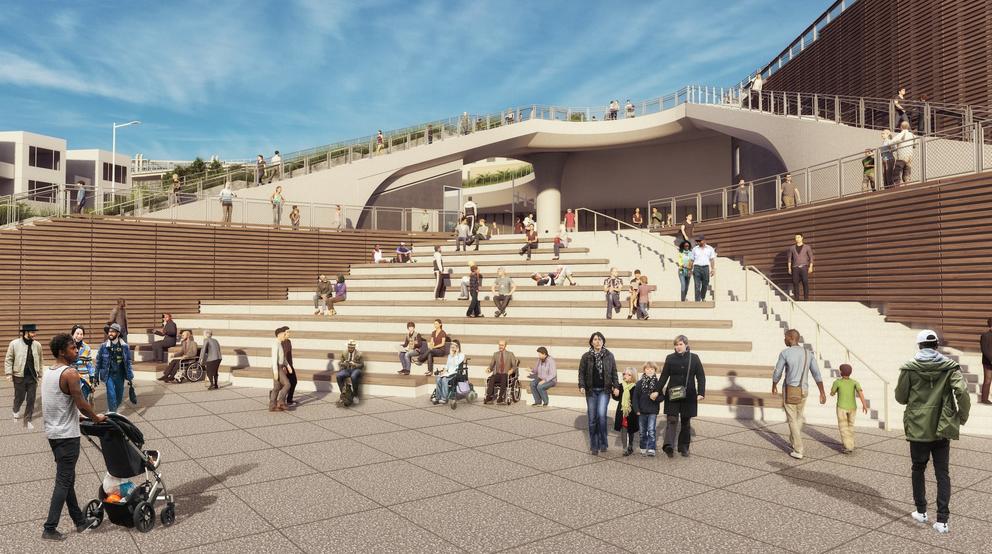As she talks in her Shelton garage-studio, Wilbur-Sigo, an accomplished artist and member of the Squaxin Island Tribe, sends her chisel down and around a bend in the wood. Wafers curl up and flutter to the ground, revealing the cedar’s pink flesh. When finished, this will be the shoulder of a towering “welcome figure,” a type of statue traditionally made by Coast Salish people to welcome visitors to their territories.
Slated to be installed later this year outside Chief Seattle Club’s new affordable housing development in Pioneer Square, “Grandmother Frog” — a woman clothed in yellow and green, arms bent forward at the elbows — will be the first Salish carving of its kind in downtown Seattle. And, at 21 feet tall with a 5-foot shoulder span, it’s the largest Wilbur-Sigo has ever made.
Once upright, “Grandmother Frog” will keep watch over the intersection of Second Avenue and Yesler Way. It’s a significant location: Here, amid a lagoon and tide flats, Coast Salish tribes long ago established a longhouse village called Sdzidzilalitch, “little crossing-over place” in Lushootseed. In the mid-19th century, white settlers — Henry Yesler among them — took and regraded the Coast Salish ancestral land to establish what is often called the “first neighborhood” of Seattle.
Not long after, Yesler and other leaders of the newly incorporated city passed an ordinance banning Native Americans from entering the city. (While the ban was short-lived, the exclusion of Native Americans continued in other ways.)
Now, more than 150 years later, “Grandmother Frog” will welcome people to this “sacred spot,” says Wilbur-Sigo. The new ?ál?al facility will include affordable housing for Native Americans and a wide-ranging contemporary art collection. “She’s there to protect, look over,” Wilbur-Sigo says. “Make people realize that we are here as a people, and we’re not going anywhere.”
“Grandmother Frog” is part of a growing crop of public artworks by local Indigenous artists that will soon appear across the city and region and send a similar message.
In the next months and years, these site-specific artworks — commissioned for Seattle Center’s new Climate Pledge Arena (opening this month), the Washington State Convention Center expansion (2022), the Seattle Waterfront Park (2024), the Seattle Aquarium’s new Ocean Pavilion and elsewhere — will be installed in lobbies, staircases and public plazas to welcome visitors and let them know: You are on Indigenous land.
“In a cultural and spiritual sense, having the Indigenous histories of the land — and the current Indigenous presence on the land — recognized in physical formats is hugely meaningful,” says local artist and curator Asia Tail. A citizen of the Cherokee Nation of Oklahoma and a member of the urban Native community in the Pacific Northwest, Tail has worked on some of these projects as a consultant of yəhaw̓ Indigenous Creatives Collective.
“Public art is a chance for people to see themselves reflected in the cityscape, which is so often incredibly colonial: gigantic buildings and steel and metal everywhere — it’s such a constant daily reminder of [these] very painful histories for many people,” Tail says. “But when we get the chance to see Native artists or other artists of color in public spaces … it can really change the way we feel in public spaces and the way we feel belonging in our cities.”
Thanks in part to advocacy from groups like yəhaw̓ and a growing awareness of how Indigenous people and histories have been marginalized in the region, the wealth of recent art commissions represents a shift in how some local authorities, institutions and art consultants attempt to recognize the original stewards of the land. The hope is to go beyond land acknowledgments — which can often feel perfunctory or performative — toward a more intentional and holistic relationship with Native nations and artists in the region.
The new Mukilteo ferry terminal, designed by LMN Architects, came about through a collaboration with local tribes. The design of the cedar-clad facility takes cues from a Coast Salish longhouse, and its light ecological footprint and permanent art collection are meant to honor the continuing tribal presence on the land. (Chloe Collyer for Crosscut)
Ancestral Shores
In December, a brand-new $187.3 million ferry terminal opened on the traditional lands of the Snohomish people. It was the result of a yearslong collaboration of 11 local tribes with the Washington State Department of Transportation and LMN Architects. The cedar-clad building (which serves one of the state’s busiest ferry routes) has a light ecological footprint, with an architectural design that takes cues from a Coast Salish longhouse. These elements — along with a permanent art collection — are meant to honor the continuing tribal presence on the land.
In Mukilteo, tribal leaders from the Lummi, Muckleshoot, Suquamish, Snohomish, Skykomish and other tribes signed the 1855 Point Elliott Treaty, ceding much of their land and retaining the right to continue to fish, hunt and gather as they had and have for generations. A sign at the terminal excerpts a 2007 letter from the Tulalip Tribes, noting “This is a living site of our ancestors, and it has immeasurable cultural and spiritual value.”
At the terminal, art is everywhere you look. Above the waiting area: a full-size canoe by Tulalip master carver Joe Gobin hangs from the ceiling. Near the ticket booth: an 8-foot diameter spindle whorl (also by Gobin) depicts ancestral connections to the waters and sea life of Puget Sound. In the elevator shaft: glass panels by Tulalip master carver James Madison portray orcas, salmon and tribal elders. And near the toll plaza stand two welcome figures by Suquamish artist Kate Ahvakana and five embossed aluminum panels by Shoalwater Bay artist Earl Davis.
Seattle and King County arts agencies are also working on a variety of large-scale projects involving local Indigenous artists, including Duwamish artist Michael Halady, who is carving a welcome figure from a 600-year-old cedar pole for the main terminal at the King County International Airport/Boeing Field (2022). Carvers Keith Stevenson and Tyson Simmons of the Muckleshoot Tribe are making a welcome figure for the new downtown Auburn Arts Alley (Spring 2022) and will also be collaborating on a public art project for a new recycling and waste transfer station in Algona, WA (2023).
Indigenous knowledge
While the region will soon be home to several new traditional Coast Salish carvings, such as welcome figures, some artists are bringing newer techniques and materials to their commissions, as well as influences from other tribes. For Guests from the Great River, installed outside the Burke Museum in late 2020, artists Tony A. (naschio) Johnson (chairman of the Chinook Nation), and artist Adam McIsaac (who is not Native), used 3D scanners to enlarge the scale of carved cedar canoe paddles, which they then cast in bronze.
For the new Climate Pledge Arena, Preston Singletary, a local glass virtuoso and a member of the Tlingit tribe, worked with Kitsap-based sculptor David Franklin (who is not Native) to craft a stained-glass-like sculpture titled “La Diab Pish,” or the Pacific Giant Octopus, which will change colors with the sun. The duo is also creating two large-scale glass and steel canoe paddle sculptures for the city of Seattle’s Ship Canal Water Quality Project (2024).
The huge Ship Canal project also includes a laser-cut fence from Tacoma-based artist RYAN! Feddersen. A member of the Confederated Tribes of the Colville Reservation, Feddersen has been swamped with a slew of large-scale, public-facing artworks lately.
She’s currently working on a 26-by-74-foot beadwork-inspired tile mural — which will grapple with Pioneer Square’s history and the settler-created city grid — for the new Citizen M hotel in Seattle (to be installed in November). And at the Portland airport, she’ll be unveiling a large work representing “the environmental personhood” of the diverse habitats of the Pacific Northwest.
Earlier this year, she unveiled the massive “Mini Tahoma,” which gives a decommissioned, two-story-tall and 175-foot-long brutalist fountain in Tacoma new life as an artwork via paint, sculpture, lighting and about 33,000 pounds of post-consumer glass pieces.
The installation is classic Feddersen: It’s a sincere tribute to the Tahoma glacier and Indigenous ways of interacting with nature (the flowers reference traditional plateau embroidery and Indigenous healing, strength and resilience) that doubles as a bit of a spoof of the fountain’s artificial nature and the hubris of attempting to tame the environment — which in turn becomes a more somber reflection on the impact of humans on Earth.
Feddersen says that with a growing interest in discussions around the climate and environment comes a new “thirst” for Indigenous art, knowledge and culture. But that’s a recent development, she says.
“It was not that long ago [that] you would see non-Native artists being hired to do commissions where they represent Native motifs and stories,” she says. “Now, when people are being encouraged to think more thoughtfully of the implications of whose voices you’re amplifying … you’re seeing more Native artists getting commissioned.”
Emerging public artists
The increase in commissions for Native artists is in part due to institutions hiring Native art consultants and crafting calls for art specifically by Indigenous artists in order to bring more people into the fold. This in turn has resulted in more commissions going to women and first-time public artists.
Asia Tail traces the changes back to a few things: mainly, the yearslong advocacy work by Native artists and others behind the scenes, as well as “a readiness on the part of mainstream agencies to actually start putting action behind these ideals of DEI — diversity, equity, inclusion — and actually realizing it.”
Private institutions and nonprofits are making similar moves. STG Presents has tapped Joseph H. (wahalatsu?) Seymour, who is Squaxin Island/Pueblo of Acoma, for a mural in the lobby of the Neptune Theater, premiering in November. The Seattle Symphony recently unveiled a large woven cedar mat by artist DeAnn Sackman, whose Duwamish lineage can be directly traced to Chief Seattle and his daughter, Kikisebloo aka “Princess Angeline.” Featuring black and red mother-of-pearl shell buttons modeled after Coast Salish iconography depicting songs, the mat will be on permanent display at Benaroya Hall.
“I’m honored for the opportunity to represent and share the culture of the Duwamish people and my fifth generation great-grandfather — who the city of Seattle is named after,” Sackman says.
Authentic Coast Salish art
While Coast Salish artists have been carving, weaving and creating art here for ages, local traditions and techniques have long been less recognized and sought-after in favor of more northern styles from British Columbia and Southeast Alaska.
At the turn of the 19th century, local businessmen stole a totem pole from the Tongass Tlingit and erected it as “the Seattle Totem Pole” in Pioneer Square with a plan to market Seattle as a Gold Rush gateway to Alaska. (The totem pole, still there, is part of a National Historic Landmark.) Ever since, totem poles — which Coast Salish people didn’t traditionally make — and formline designs featuring U-forms and ovoids became a catchall for a vague “Northwest Native” style.
But since the 1970s, prominent artists like Susan Point and Marvin Oliver (plus, in more recent years, Brian Perry, Shaun Peterson and Andrea Wilbur-Sigo, among others) have paved the way for more recognition for Coast Salish artists and representation in public art collections.
Now, with the recent surge in Indigenous public art, “there’s something new happening,” says Wilbur-Sigo. “People are getting comfortable and used to seeing Salish work,” which tends to feature more ovals, trigons, crescents, and welcome figures rather than totem poles. “All of a sudden, it’s starting to become acceptable,” she says. “It’s starting to be understood.”
“Grandmother Frog” — for now, lying on her back in Wilbur-Sigo’s garage with her head sticking out from the rolled-up door — is one of a bevy of artworks Wilbur-Sigo will be installing in the region in the next few months. Under a tarp outside, two house posts, each 10-feet tall, await transport to Olympia, where they will welcome visitors to the city. The carved paddles resting against her garage will be part of a large sculptural part-steel piece welcoming hockey fans to the new Kraken Community Iceplex in Northgate. She points to two more logs outside: “Going to the convention center,” she says.
Matriarchs to the front
Wilbur-Sigo is one of six Indigenous female artists (including Feddersen) tapped to create works for the Washington State Convention Center expansion in downtown Seattle, slated to open next year. She’ll carve two welcome figures (a “Creator” woman and “Mowitch Man”) from the rain-softened cedar logs. These will be two of a dozen large-scale Native artworks gracing the glass-and-steel building’s main entrances and greeting thousands of visitors from all over the world.
Danielle Morsette (Suquamish and Sto:lo) will contribute a woven wall-hung tapestry measuring 8 feet by 20 feet that builds on a 20,000-year-old tradition of textile weaving. Malynn Foster (Squaxin Island and Skokomish) is enshrining the idea that “We are all connected” via petroglyph-style stone carvings.
For her first-ever exterior artwork, Jennifer Angaiak Wood (Yup'ik) has designed four larger-than-life masks on sculptural stands from cast bronze, aluminum, cast glass and mosaic. Artist and architectural designer Kimberly Deriana (Mandan/Hidatsa) has created a weathered steel staircase archway inspired by “burden baskets.” From afar, the sculpture, an ode to the matriarchs and art of weaving across tribes, will look like an upside-down burden basket, literally overarching the staircase.
“Weaving and basket-making is a cross-tribal craft predominantly done by women,” says Deriana. “The concept for my piece came out of [wanting] to honor women in my work, as womb carriers and givers of life. I always try to incorporate women’s roles in my design process,” she says.
This swell of prominent public work by Indigenous women is remarkable, Deriana says. Within the already-marginalized Indigenous arts, women have been long cast aside, their work often devalued as “craft” rather than “art.” Before colonization, Deriana says, women were the architects in Mandan and Hidatsa cultures. Now architecture, urban design and even public art are male-dominated fields.
“I feel like it's important for us to stick together and to support each other in these spaces, which previously belonged to us,” she says.
Also noteworthy: five of the Indigenous women making art for the convention center are also working on a collaborative design that will take the shape of a 20-foot-tall, steel wall sculpture at the Olive Way entrance. Each of the artists designed one of five S-shaped kelp branches to represent their individual cultures and influences. Together, the seaweed represents the strength of Indigenous women, as they put it in their art statement, “doing work ‘under the surface’ that can be difficult to see but that is critical to the continuance of our cultures.”
“It feels very matriarchal and something that our grandmothers would have wanted us to build and create,” Deriana says. “Collaborative making is something we’ve always done, but now that we’re so dispersed regionally, we don’t always get to. A lot of artists are trained in a non-Indigenous framework,” she notes. “And so we don’t get to work the way that our ancestors do.”
“Re-Indigenizing” Seattle
Deriana is continuing the collaborative ethos with a newly formed group of Indigenous art makers called MTK Matriarchs, whose members include Deriana, Foster and Tamela Laclair (Skokomish). The group has been commissioned to design a large-scale installation for Seattle’s forthcoming Waterfront Park, on the amphitheater-style Salish Steps that will connect the lower portion of a new pedestrian bridge to the promenade. While they can’t reveal much yet, the team plans to honor the art of weaving and the teachers who have fostered the art form.
“We, as Indigenous artists, face the unique challenge of representing a line between Western concepts of art-making in public space and the truth of our own experiences and responsibilities to our own culture,” LaClair says.
Today, much of the waterfront still looks like a construction site, with fences, cranes and barges full of sand. It takes some imagination (or virtual reality goggles) to visualize how this part of the city will, once again, be profoundly reshaped.
Originally a place where Indigenous tribes hunted, gathered shellfish and traded, the tideflat shoreline was expanded and infilled over the past centuries. After Indigenous people were dispossessed from the land, the waterfront took on many different incarnations. By 2024, its latest transformation should be complete: a 20-acre public park spanning two-dozen blocks and connecting the shoreline to Pioneer Square, Pike Place Market, the convention center and Capitol Hill.
Though the original footsteps are long paved over, the project will have an Indigenous, particularly Coast Salish, footprint. Near the Colman Dock, visitors will be able to walk through a colonnade of house posts and beams inspired by longhouses. It’s a public art piece envisioned by (non-Native) artist Oscar Tuazon, assisted by Randi Purser (Suquamish), Tyson Simmons (Muckleshoot) and Keith Stevenson (Muckleshoot).
In addition, renowned Puyallup artist Qwalsius, also known as Shaun Peterson, is preparing a trio of cedar and bronze welcome figures that will reflect the Coast Salish tribes and the historic connection to the Seattle waterfront.
“It’s a really powerful, sacred site,” Deriana says of the waterfront. The MTK Matriarchs’ artwork, and Indigenous public artwork in general, is just one way of re-Indigenizing Seattle, she says. From “Landback” to a societal shift towards reciprocity with the land and each other — there’s lots of work ahead.
For now, “Our goal is to use public art as a tool to both decolonize and indigenize our space along the waterfront. Open the public eye and immerse people into our culture and way of life,” says Laclair. “Honoring our teachings, cultural traditions and making our ancestors proud.”
This story has been amended to clarify that, with the signing of the Treaty of Point Elliott, representatives of the tribes did not exchange their land to acquire the right to hunt, gather and fish in their “usual and accustomed places,” but rather, retained that right.

